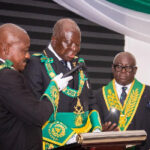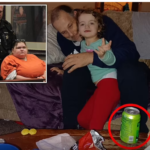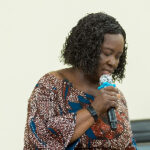- NST : National Standardized Test
- NaCCA : National Council for Curriculum and Assessment
- SHEP : School Health Education Programme
- STMIE : Science Technology Mathematics Innovation and Engineering
- SPED : Special Education Division
- SIE : Special and Inclusive Education
- SEIP : Secondary Education Improvement Project
- WITED : Women in Technical Education
- ECE : Early Childhood Education
- CBE : Complementary Basic Education
- CSSPS : Computerized School Selection and Placement System
- NAGRAT : National Association of Graduate Teachers
- GNAT : Ghana National Association of Teachers
- CCT : Coalition of Concern Teachers-Ghana
- TEWU : Teachers and Educational Workers Union
- INSET : In-Service Education and Training
- CBI : Cluster Based INSET
- SBI : School Based INSET
- CBE : Complementary Basic Education,
- EMIS : Education Management lnformation System
- GALOP : Ghana Accountability For Learning Outcomes Project
- DEOC : District Education Oversight Committee
- DTSTs : District Teacher Support Teams.
- ESA: Education Sector Analysis.
- SISO : School Improvement Supporting Officer
LET THESE DATES GUIDE US AS WELL
■1951- Accelerated
Development Plan for Education
■1952. Waec was established
■1957. MOE was established
■1961- Fee-Free Basic Education
■1963 – Free Supply of Textbooks
■1964 – Continuation School Programme
■1976 – Experimental JSS
■1976 – Introduction of 3-year Post Secondary Teacher Education
■1987 – JSS replaced middle school
■1988 – Nationwide implementation of JSS Education concept
■1988 – Decentralization Policy at Basic School level
■1993. NAB was established in
■1995 – Introduction of FCUBE
■2003 – Introduction of Capitation Grant
■2005 – CSSPS
■2006. WASSCE REPLACED SSSCE
■2007. FWSC was established with act 2007 (737)
■2008 – Teacher Training College became College of Education
■2008. Education Act 2008 (778)
■2008. Act 2008 (Act 766) provides SSNIT to establish the contributory Three-Tier Pension Scheme
■2015 – Progressively free SHS Education
■2014 – Polytechnics Upgraded to Technical Universities
■2017 – Introduction of Free SHS
■2017 – Free SHS Educational policy
Pre-Tertiary Education Act 2020 (Act 1049)
In brief, Act 1049 spelt out the mandate and structures of Pre-Tertiary Education in Ghana. This Act divides Pre-Tertiary Education into two (2) divisions/sections:
Section A: Ghana Education Service(GES)- GES currently has Dr. Eric Nkansah as Director General.
Section B: Ghana Technical and Vocational Education and Training (TVET) Service. TVET Service currently has Mrs. Mawusi Nudekor Awity as Director General.
The GES and TVET Service are the main agencies of MoE mandated to manage Pre-Tertiary education in Ghana.
They have almost the same structure, DG, Two Deputies to the DG and Governing Board/Council.
The GES and TVET Service have the same relation with other regulatory agencies such as NTC, NaCCA, NaSIA, etc.
Ranks in Ghana Education Service
- Director General– Based on political appointment
- Deputy Director General
-advertisement-
There are two deputies
a. One in charge of Access & Quality
b. The other is in charge of Management Services
- Director I – Long service. They are the Divisional/Regional Directors.
- Director II – also long service – They are the District Directors.
- Deputy Director – long service – They are usually appointed as Assistant District Directors.
- Assistant Director I – long service – Can be appointed as Circuit supervisor or heads of Senior High Schools.
- Assistant Director II – Long service, and promotion upon acquisition of masters degree or PhD. Can be appointed as a Head of Basic School.
- Principal Superintendent – Long service, and entry point for first degree holders. Minimum requirement for appointment as a teacher in the Senior High School. Now the new Minimum for appointment as a Basic School Teacher.
- Senior Superintendent I – long service – Four years of serving on the rank of Snr Supt II.
- Senior Superintendent II – Entry point for Diploma certificate holders. Used to be the requirement for appointment as Basic School Teacher.
- Superintendent I – long service, Four years of serving on Supt II.
- Superintendent II – Entry rank for (Cert A) holders.
- Pupil Teacher- The rank of those employed into the service with SSCE, WASSCE AND GCE as well as those who couldn’t pass all their papers in college before employment. Previously, whether you pass all courses in college or not, you will be posted before you take steps to redeem yourself*
- A teacher who breaks service may re-enter the service by applying for……..
Ans. Re-engagement - A teacher who was absent from school without permission for more than 10 working days is said to have —-
Ans. Vacated post - A teacher returning from Secondment can apply for………………….
Ans. Reinstatement - The transfer of a teacher within the District called ——
Ans. Intra District Transfer/Reposting - The Double-Track system of Education can be described as ……..ntervention
Ans. Policy - An Education system which ensures education for all is described as—————educational system
Ans. Inclusive education - Which centre in the KG classroom allows pupils to practice writing with ease?
Ans. Sandy corner - Sports and games and general cleaning in the dormitories can be referred to as what?
Ans. Co curricular activities - Teacher Training Colleges became Colleges of Education in which year
Ans. 2008 - What is the highest decision making body at the SHS level ?——–
Ans. Board of governors - Which one of the followings indicates child’s physical growth?
A. Negative
B. Quantitative
C. Qualitative
D. Positive
Ans. B:Quantitative - In which year was the JSS or JHS piloted?
Ans. 1976 - The best method to study growth and development of the child is–
A. Psychoanalytic Method
B. Comparative Method
C. Developmental Method
D. Statistical Method
Ans. : Developmental method - Which of the following statements is not true?
A. Growth is a biological process
B. Development is a quantitative process
C. Education is a goal-oriented process
D. Learning is a process of behavioural changes
Ans.
B: Development is a quantitative process - Kwapong Education Review Committee (formed in 1966) – Introduced Continuation School concept in 1967.
- Dzobo Education Review Committee (formed in 1974)- established the New Structure and Content of Education, NSCE, which proposed the JSS concept.
- 1975/76 academic year: JSS started on pilot/experimental basis.
- The Anfom Education Review Committee (formed in 1986)- recommended the nationwide JSS concept.
- 1987/88 academic year: JSS was implemented nationwide.
- The Anamuah-Mensah Education Review Committee recommended the conversion of JSS and SSS into JHS and SHS respectively under the 2007 Educational Reform.
Mandate of GES GES is responsible for the implementation of pre-tertiary educational policies of the Government to ensure that all Ghanaian children of school-going age irrespective of tribe, gender, disability, religious and political affiliations are provided with good quality formal education.
GES implement policies. MoE formulates policies














